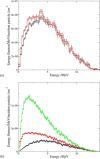A Monte Carlo evaluation of beam characteristics for total body irradiation at extended treatment distances
- PMID: 24892344
- PMCID: PMC5711064
- DOI: 10.1120/jacmp.v15i3.4708
A Monte Carlo evaluation of beam characteristics for total body irradiation at extended treatment distances
Abstract
The aim is to study beam characteristics at large distances when focusing on the electron component. In particular, to investigate the utility of spoilers with various thicknesses as an electron source, as well as the effect of different spoiler-to-surface distances (STSD) on the beam characteristics and, consequently, on the dose in the superficial region. A MC model of a 15 MV Varian accelerator, validated earlier by experimental data at isocenter and extended distances used in large-field total body irradiation, is applied to evaluate beam characteristics at distances larger than 400 cm. Calculations are carried out using BEAMnrc/DOSXYZnrc code packages and phase space data are analyzed by the beam data processor BEAMdp. The electron component of the beam is analyzed at isocenter and extended distances, with and without spoilers as beam modifiers, assuming vacuum or air surrounding the accelerator head. Spoiler thickness of 1.6 cm is found to be optimal compared to thicknesses of 0.8 cm and 2.4 cm. The STSD variations should be taken into account when treating patients, in particular when the treatment protocols are based on a fixed distance to the patient central sagittal plane, and also, in order to maintain high dose in the superficial region.
Figures







Similar articles
-
Monte carlo electron source model validation for an Elekta Precise linac.Med Phys. 2011 May;38(5):2366-73. doi: 10.1118/1.3570579. Med Phys. 2011. PMID: 21776771
-
Monte Carlo modeling of a 6 and 18 MV Varian Clinac medical accelerator for in-field and out-of-field dose calculations: development and validation.Phys Med Biol. 2009 Feb 21;54(4):N43-57. doi: 10.1088/0031-9155/54/4/N01. Epub 2009 Jan 14. Phys Med Biol. 2009. PMID: 19141879 Free PMC article.
-
Monte Carlo optimization of total body irradiation in a phantom and patient geometry.Phys Med Biol. 2013 Apr 21;58(8):2461-9. doi: 10.1088/0031-9155/58/8/2461. Epub 2013 Mar 21. Phys Med Biol. 2013. PMID: 23514805
-
Electron beam therapy at extended source-to-surface distance: a Monte Carlo investigation.J Appl Clin Med Phys. 2008 Oct 24;9(4):57-67. doi: 10.1120/jacmp.v9i4.2811. J Appl Clin Med Phys. 2008. PMID: 19020487 Free PMC article.
-
Monte Carlo-based treatment planning for a spoiler system with experimental validation using plane-parallel ionization chambers.Phys Med Biol. 2004 Nov 21;49(22):5145-55. doi: 10.1088/0031-9155/49/22/009. Phys Med Biol. 2004. PMID: 15609564
References
-
- AAPM . The physical aspects of total and half body photon irradiation. AAPM report 17. A report of Task Group 29 Radiation Therapy Commlttee. Philidelphia, PA: American Institute of Physics; 1986.
-
- Podgorsak EB and Podgorsak MA. Special procedures and techniques in radiotherapy. In: Podgorsak EB, techical editor. Radiation oncology physics: a handbook for teachers and students. Vienna: International Atomic Energy Agency; 2005.
-
- Total body irridation. In: Khan FM, editor. The physics of radiation therapy, 4th edition Philadelphia, PA: Lippincott Williams & Wilkins; 2010.
-
- Gilson D and Taylor RE. Total body irradiation. Br J Radiol. 1997;70:1201–03. - PubMed
-
- Kassaee A, Xiao Y, Bloch P, Goldwein J, Rosenthal DI, Bjärngard BE. Doses near the surface during total‐body irradiation with 15 MV X‐rays. Int J Cancer. 2001;96 (S1):125–30. - PubMed
MeSH terms
LinkOut - more resources
Full Text Sources
Other Literature Sources

